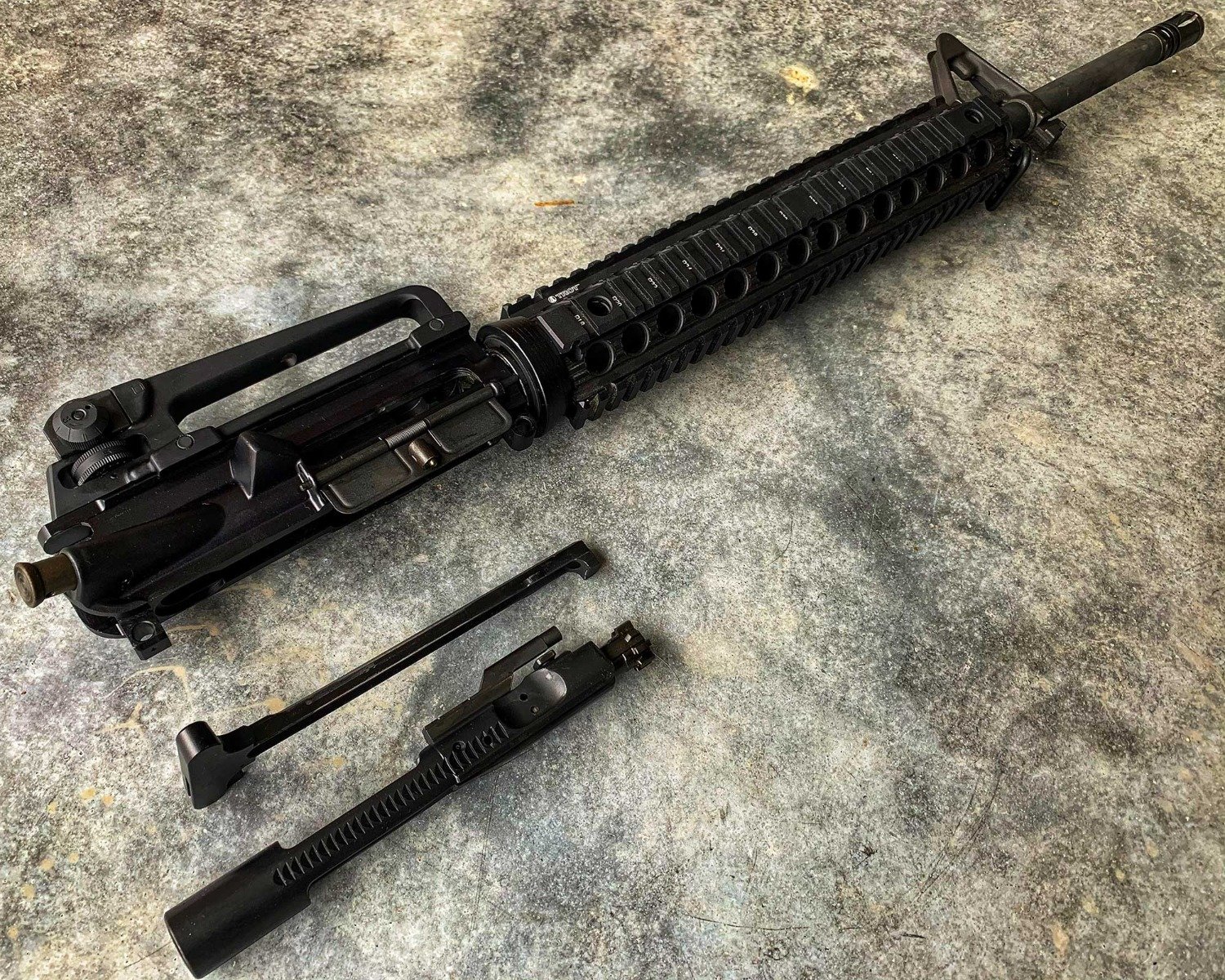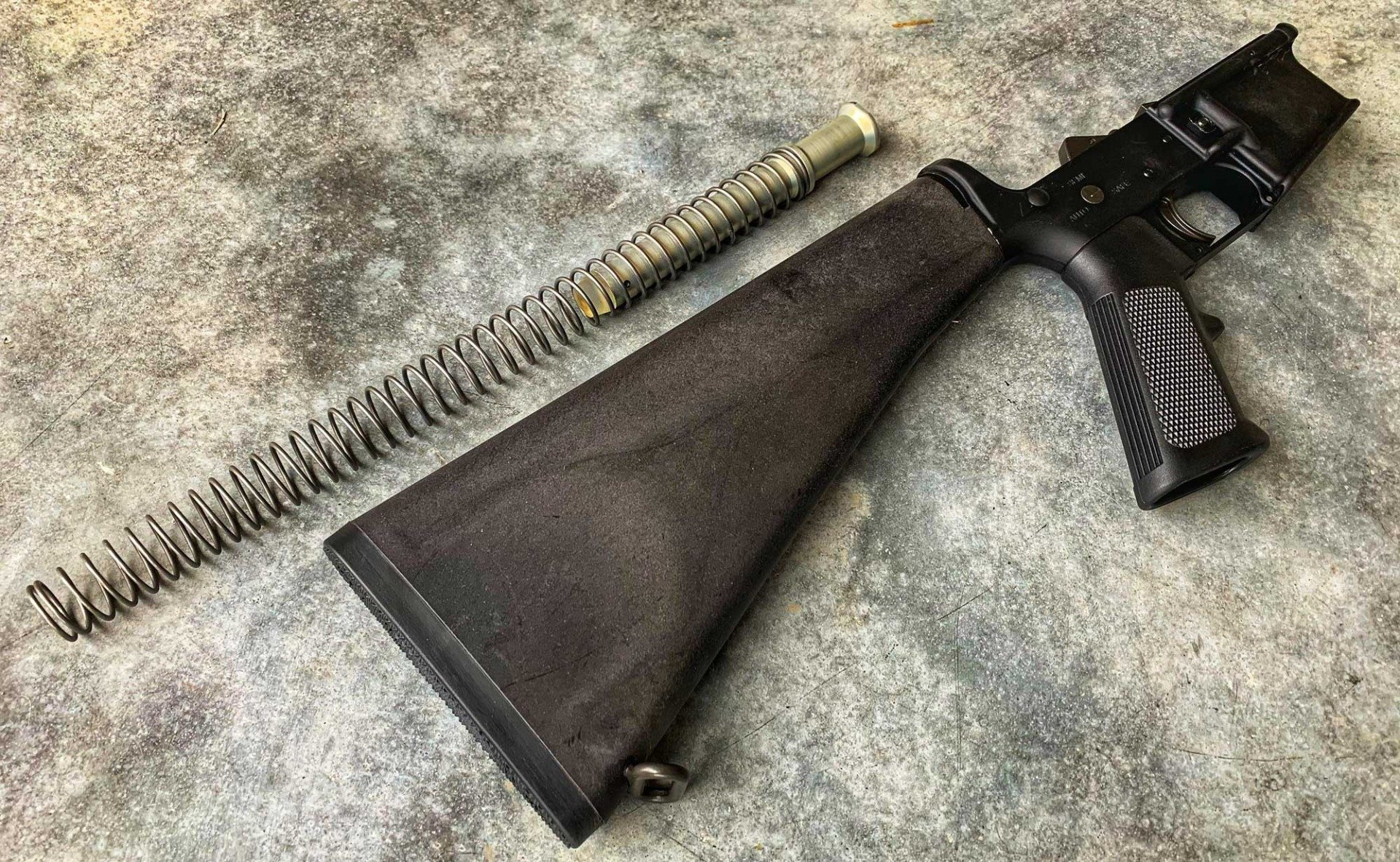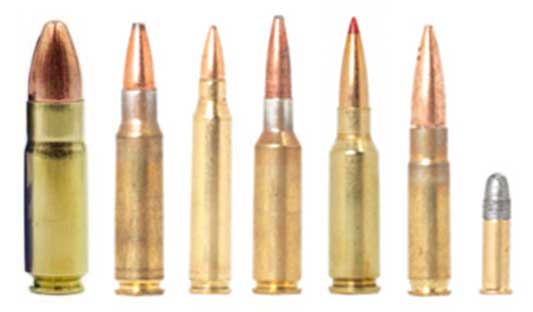The AR-15 is the most prolific American rifle of the 20th and, so far, the 21st Century. There are as many as 10 million AR-15 rifles in circulation and many first-time buyers are looking to get one. But, the new gun owner may be confused about many aspects of the AR-15 and have a lot of questions. Some of these questions could be where did the AR-15 come from? What does AR-15 even mean? What are the differences between an AR-15 rifle and a pistol? What calibers can the AR-15 utilize? Or even, what attachments or accessories does it use? For many new gun owners, these questions have gone unanswered and could cause them to be intimidated when buying their first rifle.
Let’s try to answer these questions to get some basic information into your hands in hopes of giving you what you need when deciding on when, how and what to buy.
THE AR-15: A BRIEF HISTORY LESSON

The origin of the AR-15 starts with Eugene Stoner and his idea to create a lighter service rifle for the U.S. military. His first design was a .308 caliber rifle called the AR-10. This rifle was a larger heavier predecessor of the AR-15 meant to replace the M-1 Garand and M-14. The Air Force decided it did not like the larger version and requested a rifle in the intermediate-sized cartridge of .223 Remington. Stoner, with the help of ArmaLite, adapted the AR-10 to the AR-15 and presented it to the Air Force for evaluation. This design was eventually adopted as the M-16 and has served the US Military well for nearly 60 years. This is a very simplified version of the creation and adoption of this rifle into the military; however, this gives you a basic understanding of how this rifle was born.
WHAT DOES THE “AR” IN AR-15 STAND FOR?
The AR in AR-15 has been defined as “assault rifle” or “assault rifle 15” by the mainstream media which could not be further from the truth. This is done to push a very specific agenda of demonizing this rifle. However, when Eugene Stoner developed this rifle, he did so with the manufacturing help of the company called ArmaLite. In reality, the AR stands for “ArmaLite Rifle” or “Armalite Rifle 15.”
MAJOR AR-15 COMPONENTS: THE UPPER AND LOWER RECEIVER
The AR-15 is one of the most over-engineered and modified rifles. This rifle is extremely simple in its design and operation despite its appearance because of its over-engineering. The rifle can be split into 2 major components and then into several minor pieces. These two major components are the upper receiver and lower receiver.
The Upper Receiver

The upper receiver, AKA the upper, is usually made from 7075 T6 forged aluminum and houses the bolt carrier group (BCG), charging handle, and barrel. The steps of firing a bullet, also known as a round, are feeding, chambering, locking, firing, unlocking, extracting, ejecting, and cocking which is contained within the upper. Once that process is completed it starts all over again for the next round. Since there is so much happening in the upper, special care was put into the design to make replacing parts easy and relatively quick.
The barrel is seated into the front of the upper and is tightened down by a barrel nut. Since the upper is forged in universal agreed-upon specifications, there are normally very few adjustments needed when installing a barrel to the upper. The BCG and charging handle attach and slide into the upper and are instrumental in firing a round.
Some of the lesser components of the upper receiver are the gas block and gas tube, handguard, muzzle device, and front and rear sights. While all these parts are needed to efficiently operate the rifle they could technically be left off and the AR-15 could still shoot, albeit with far more difficulty. The gas block and the gas tube will funnel burning gases, as a round is shot, from the barrel to the BCG to force it rearward and continue the steps of firing a round. The handguard will surround the barrel, gas tube, and sometimes the gas block, to protect the shooter’s hand from those components as it heats up from shooting. Front and rear sights are naturally there to accurately aim the rifle. Finally, the muzzle device is used to dampen flash from the muzzle, compensate against the rising of the muzzle as multiple rounds are fired, or a combination of flash suppression and compensation.
The Lower Receiver

The lower receiver, AKA the lower, is also usually made from 7075 T6 forged aluminum and houses the magazine well, the fire control group, receiver extension or also known as the buffer tube, buffer, buffer spring, buttstock, and pistol grip. The lower’s primary function is to provide a shooter the ability to grip and shoulder the rifle, supply rounds to the upper, and the ability to fire a round by way of the trigger and hammer. This is also the serial number component and requires it to be transferred to its owner through a Federal Firearms Licensee (FFL).
Magazine Well – a hole on the bottom side of the lower where the box of rounds, or the magazine, is inserted to feed the upper.
Fire Control Group – installed inside the lower and encompasses the trigger and hammer.
Receiver Extension – can be external to the lower or embedded in the buttstock and will retain the buffer and buffer spring. These two pieces are used to cushion the BCG as it replicates and allows it to return to its starting point.
Buttstock – the component placed against your shoulder and can be fixed or telescoping for added comfort.
Pistol Grip – what is gripped by the shooter’s firing hand allowing a person the ability to comfortably pull the trigger.
The lower and upper receiver are attached and retained by the receiver retaining lugs and pins. Once the upper and lower are conjoined, it creates a rifle that can be extremely easy to assemble and disassemble for cleaning and maintenance on your AR. This lug and pin design also allows for a very tight lock between the two receivers that aids in its accuracy and reliability.
CALIBERS OF THE AR-15

The genius of Eugene Stoner’s design cannot be emphasized enough in its versatility. While the original rifle was designed for the .223 Remington and 5.56x45mm NATO cartridges, this rifle has been adapted to shoot several other calibers.
The AR-15 calibers include, but are not limited to:
- .22LR
- 300 Blackout
- .458 SOCOM
- 6.5 Grendel
- .224 Valkyrie
- 6.8 SPC
- .50 Beowulf
These different calibers can utilize the standard AR-15 magazine or may require a special magazine that is the same dimensions as the standard magazine. But, in most cases, the special magazines will still fit into the standard lower receiver. Most people will keep the same lower and purchase different uppers to match the caliber they wish to shoot. The ease of disassembly allows the shooter to quickly swap calibers depending on the need of the shooter. A hunter can shoot prairie dogs in the morning with .223 Remington and change to 6.5 Grendel for deer hunting in the evening that can be accomplished in seconds.
BASIC ATTACHMENTS AND ACCESSORIES FOR CUSTOMIZING
In addition to the large variety of calibers, the modern AR-15 can be easily customized to your liking. Many attachments and accessories are focused on sights, optics, bipods, forearm grips, pistol grips, and buttstocks to ensure the correct ergonomics to the rifle’s owner. Scopes, optics, bipods, and forearm grips are typically attached by using the M-1917 Picatinny sections for ease and quickness of attaching anything you want.
The traditional fixed iron sights are exactly what you have seen in movies or what your grandfather used with the M-16 in Vietnam. However, the more modern ARs can also accept low-profile flip-up sights that will reduce interference to an optic. These flip-up sights can be easily and quickly deployed should an optic break or fail. Individuals that like to use fixed powered optics also have the ability to attach 45-degree offset iron sights. These sights basically hang off the side of the rifle to allow the shooter to easily rotate to look through the iron sights for shoots that may be too close to see in the fixed-powered scope.
Optics, whether they be red dot sights or magnified scopes, have gained huge popularity in the last 20ish years. The U.S. military needed to find every advantage to fight a resilient enemy as it got entrenched in the Global War on Terrorism (GWOT). The longer GWOT lasted the more companies pushed the envelope as to what could improve the rifle’s sighting capabilities. Now, you can attach a simple red dot reflex sight, a 3 or 4 power fixed scope, or even optics with variable magnification. Variable magnification optics, such as the 1-6 or 3-14 power scopes, have been instrumental in extracting the most accuracy out of the rifle but also pushing manufactures to develop rifles to shoot longer distances.
Bipods are essentially foldable or retractable sticks attached to the front of the rifle to stabilize it to increase accuracy. Most people will use bipods for rifle setups that are meant for extreme precision and are commonly referred to as designated marksman rifles (DMR). These rifles will usually incorporate fixed buttstocks, high power variable optics, and upgraded fire control groups that will have lighter pulling triggers.
Buttstocks are capable of being changed to the owner’s preference. If someone is wanting a DMR style rifle, a fixed stock may be used to create the most stable platform to shoot as far and/or accurate as possible. However, if an AR is to be used for home protection, a telescoping buttstock and a shorter barrel can be far more useful.
THE DIFFERENCES BETWEEN THE AR PISTOL AND RIFLE
The BATFE classifies any firearm to be a rifle if it has a barrel length of 16 inches or longer and an overall length of or longer than 26 inches. Any rifle shorter than this and the government has decided that it needs to be restricted and requires you to pay $200 for a tax stamp. This process is used to execute an additional background check, make you provide fingerprints, and have your weapon on a federal registry.
However, clever Americans have found there are no laws that required an owner of an AR-15 shorter than 26 inches without certain accessories to follow the tax stamp process. So, if you owned an AR-15 without a buttstock and foregrip then it is considered a pistol as per current laws. Since the AR-15 pistol has become mainstream, there have been several manufacturers looking to allow disabled veterans the ability to partake in shooting and have developed stabilizing braces and blades.
As mentioned, AR pistols are going to have a shorter overall length due to many of these firearms will have barrels under 16 inches. These firearms have become extremely popular for many to use as home defense guns since they are so compact and easy to move around corners.
AR-15 rifles, on the other hand, will typically have barrel lengths of 16, 18, or 20 inches and have a fixed or telescoping buttstock. These rifles are going to be softer shooting and more accurate. A longer barrel will give a bullet more time to stabilize since it will be able to twist more times as it travels down the barrel. Accuracy can also be attributed to a longer set of iron sights or the ability to utilize larger magnified optics.
BUYING AN AR-15: THE DOS AND DONT’S
The first thing to know about buying an AR is that you cannot purchase one online and have it shipped directly to your home. This is a lie that has been passed around by politicians and anti-gun advocates to push an agenda to restrict the ownership of these rifles. Another important aspect of buying an AR is to ensure you research the laws and regulations in your state and/or jurisdiction. There may be specific restrictions in your area that may prevent you from purchasing an AR-15 or certain features.
If you find a rifle that you like online, you will need to locate an FFL near you to have it shipped to. You will need to coordinate with your local FFL to send the person/company selling the AR their FFL their documents via email or fax so that the seller knows where to ship and to document the transfer. Once it arrives at your FFL, you will need to complete an ATF Form 4473 and a background check. This process may take 15-20 minutes depending on the time it takes you to fill out the form and conduct the background check. Providing that your background check comes back approved, you will be able to take your rifle home. This is also the same process should you want to build your own AR-15.
BUILDING AN AR-15
As just mentioned, you can build your own rifle piece-by-piece with an AR-15 Kit! Many have called the AR-15 “Legos for adults” since most of the components can be installed with basic tools. For first-time builders, this may be the best way to go. However, there will be some components that will need special tools like the barrel and castle nut for the buffer tube. Usually, an AR-15 armorer’s wrench, brass hammer, and some punches are all that will be needed. New builders may want to do some research as to what special AR-15 tools the rifle they want to build may require.
If there is a specific look or features you are after, building it yourself is the way to go! You will have complete control as to what it looks like and the specific parts that are used to create your perfect firearm. The completed and/or stripped lower receiver (incomplete) will be the only piece that is required to be transferred to your FFL. The remaining components, upper receiver, barrel, handguards, sights, optics, the fire control group, buttstock, pistol grip, and any other items you may want on your AR can be mailed directly to your house. If you are not concerned about the specific parts your rifle has, many manufacturers, like Palmetto State Armory, will have build kits that will have all the components you will need to build minus the lower receiver. This makes pulling your firearm together so much easier since most everything comes in one package and perfect for the first-timer.
WRAPPING IT UP
The ArmaLite Rifle is the most modular and versatile rifle on the market today. The ability to customize the rifle to your specific need makes it desirable to many people. A lot of veterans also like to recreate the rifle that they carried while they were in or deployed. Having a rifle that is capable to switch calibers also makes it incredibly useful for hunting and home defense. If you have not bought your first AR-15, the time is now and Palmetto State Armory is the place.
Mark Grimsley is a former U.S. Army Officer that started his career as an enlisted Abrams crewman. He has served in 3 overseas tours that include Korea in 2002, Iraq in 2003 as a tank gunner and Afghanistan in 2010-11 as a logistics officer. He completed numerous military schools to include Air Assault and Airborne as well as over civilian firearms training. Mark enjoys spending time with his children, running a YouTube channel and working out.
